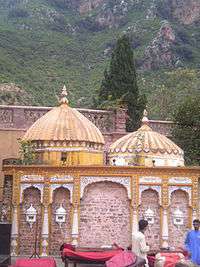Saidpur, Islamabad

| Saidpur Village | |
|---|---|
| Saidpur | |
| Coordinates: PK 33°44′31″N 73°04′04″E / 33.742077°N 73.067708°E | |
| Country |
|
| Province | Punjab |
| Elevation | 620 m (2,030 ft) |
| Time zone | PST (UTC+5) |
Saidpur is a Mughal-era village on the slopes of the Margalla Hills and located off the Hill Road to the east of Daman-e-Koh in Islamabad. The village has the footprints of various civilizations, including Gandhara, Greek, Buddhist, Mughal, Ashoka and the colonial periods, and now serving as a popular recreational spot for both local and foreign visitors.
History
Saidpur is named after Sultan Said Khan, son of Sultan Sarang Khan, the Gakhar chief of the Pothohar region (who ruled from Attock to Jehlum) during the reign of the Mughal Emperor Babur.
Said Khan gifted Saidpur village to his daughter who was married to Mughal emperor Jahangir son of Mughal emperor Akbar. Jahangir's memoir, Tuzk-e-Jahangiri mentions him residing at a place “beyond Rawalpindi”, on his way to Kabul, which is believed to be Saidpur.
Saidpur was considered a garden resort and a perpetual spring provided water for drinking and for watering gardens around during the Mughal period.
The village was converted into a place of Hindu worship by a Hindu commander, Raja Man Singh. He constructed a number of small ponds: Rama kunda, Sita kunda, Lakshaman kunda, and Hanuman kunda. The region is home to many Hindu temples that have been preserved; showing the history of Hindu civilisation and architecture in the region.
Remodelling of Saidpur
In 2006, the Capital Development Authority, under the leadership of Mr. Kamran Lashari, initiated the project of remodelling the Saidpur village aimed at providing the visitors with the glimpses of multi-cultural heritage flourishing under the Margalla Hills.
The government of France provided technical assistance in remodelling and a leading French architect Max Boisrobert visited the site on the invitation of Ambassador of France Mr Regis de Belenet who assured full cooperation of his country in establishing the recreational spot. Max suggested many ideas and techniques to preserve the natural impact of the village during its remodelling.
The initial cost of the project was estimated to be around 400 million rupees.[1]
Tourist attraction

In 2008, the Capital Development Authority completed the remodelling of Saidpur into a tourist attraction by giving it the look and feel of a quaint village. The key changes that have come about include the re-doing of a temple, the cleaning up of a stream running through the village and giving the mud houses a facelift. The village reflects the traditional ambience; the temple, the stones used on the walls, the stacks of hay, the horse-drawn carts and everything else depicts the history of Pothohar region.[2]
- Preserved old school building
- Restaurants & Cafe's
- Nomad Art Gallery
- Preserved old Sufi tomb
- Preserved Hindu temple & Gurdwara
See also
Picture gallery
| Images of Saidpur | ||||||||
|---|---|---|---|---|---|---|---|---|
|
References
Trivia
A Ufone advertisement has been filmed in this village. Ufone "Duniya ki sasti tareen call"
External links
| Wikimedia Commons has media related to Saidpur Village. |




